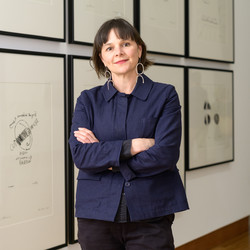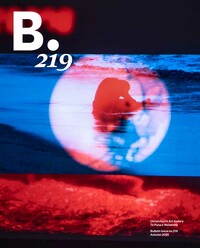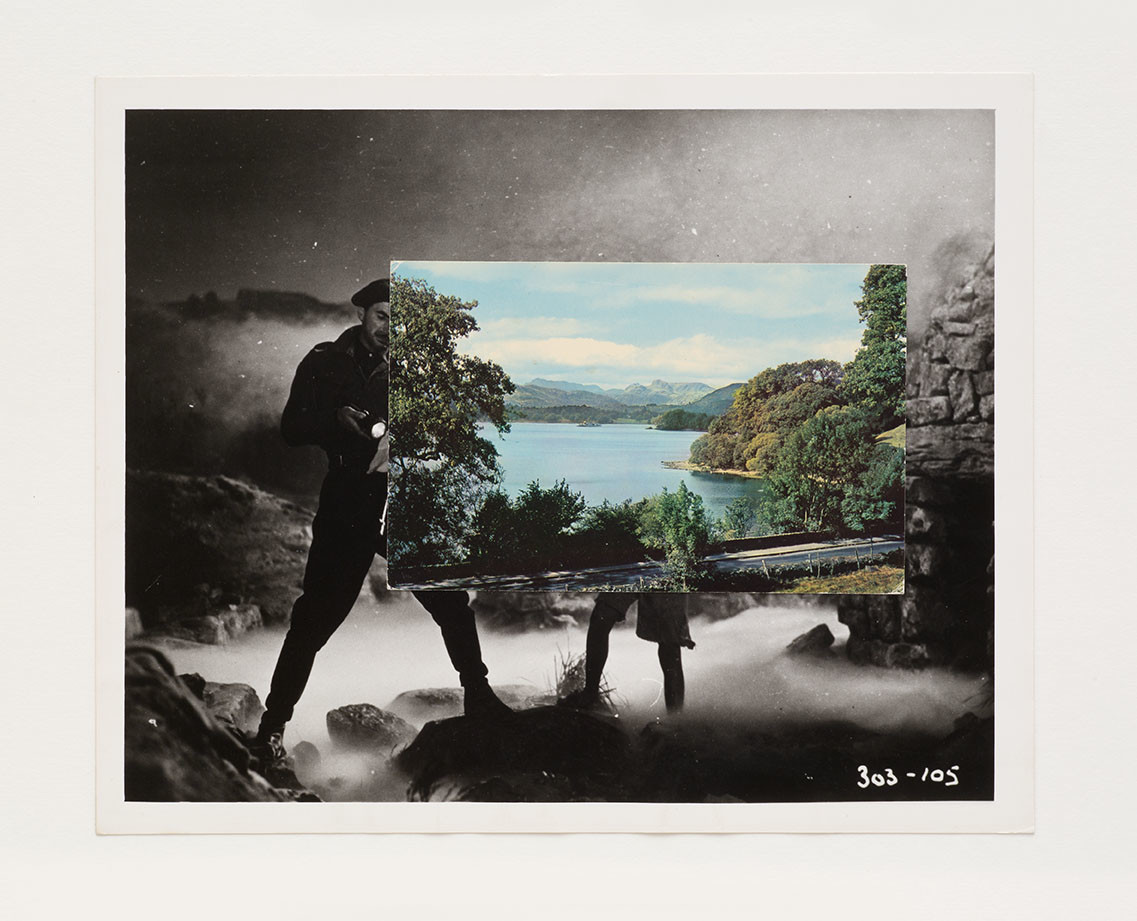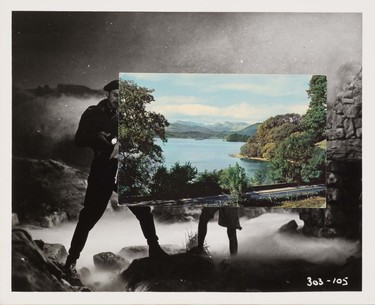
John Stezaker Clearing 2017. Collage. Courtesy The Approach, London
Sometimes Going Back Is A Way Of Going Forward
John Stezaker is an English conceptual artist, acknowledged as a significant influence on the YBA generation. He has been working since the mid-1970s, while achieving international acclaim for his work in the past fifteen years. His exhibition Lost World opens at Christchurch Art Gallery in March 2018. He spoke to senior curator Lara Strongman on a visit to Aotearoa New Zealand in August 2017.
Lara Strongman: You have a determinedly analogue process – you use a scalpel and glue rather than a computer. How do you go about making your works?
John Stezaker: I have all sorts of spaces where I’m supposed to work. I have a desk but I always end up working in inconvenient places. I like to work on a sofa. I used to work on the floor. My wife gets terribly irritated. She says I always end up working on the kitchen table, which is the only surface that she keeps clear. I can’t go to the studio to work, it almost immediately destroys the impulse. I usually start work through a process of digression – I have some images that have come by post, I open them, and I think they might be interesting to use with another image that I got from somewhere else. The process of work begins when I leave the scene. I have a particular idea in mind, and usually it’s a sequel to something else or part of some unfinished business, and often it takes me two or three digressions before I’m lost, and at that point things happen. Then I can open up a space in which something unexpected imposes itself on me.
LS: You’ve accumulated a vast archive of images: a quarter of a million discarded photographs. What’s in your archive? And how do you organise the images?
JS: I have very simple distinctions. Apart from my collection of postcards, landscape photographs and so on, the biggest collection relates to cinema. Within that, there are the film stills and the publicity portraits. That’s the first division. These days, with the closure of many of the junk shops where I used to buy this material, and the closure of the film ephemera specialist shops, I’m now buying a lot online. I have people in different countries that collect for me. I ask them for damaged or unwanted material, which arrives in cardboard boxes through the post, and it’s like Christmas. And then I unpack them and portraits go one way, and film stills go the other. I subdivide them into male and female. My boxes are marked he and she, like towels in the bathroom or something. I also have a subdivision between head portraits and three-quarter length portraits. There are other subdivisions, but they’re very general. For example, I have collections of people smoking or on the telephone, but they’re not always that useful actually. Even that limited ordering can be a constraint on the encounter with the unexpected. Sometimes I find I have to resort to the unsorted boxes to get some inspiration.
LS: You’ve talked before about working late into the night fuelled by coffee and tiredness. What does that way of working bring to your practice?
JS: I do think of my practice as being nocturnal. There’s something about the night. It’s not just the silence; it’s more than just a metaphor for being alone. There’s a feeling that it’s just me and that image. Philip Guston talked about all the voices disappearing until finally the last voice you let go of is your own, and I understand that. But there is something I think is essentially nocturnal, not just about my practice but about art itself. I think of my images as afterimages. They begin life as communication in daytime circulation you might say, in the media; and then through obsolescence, they are recovered as images in their nocturnal afterlife. In the collection they take on this dark aura of fascination, which I take to be nocturnal. I feel as if they are overlooked in their daytime use and are almost invisible in their subservience to meaning, use and succession. But they are released to reveal themselves in their nocturnal aspect. It sounds very romantic but the image seems to be illuminated by a different kind of light entirely.
LS: And the sense of an underworld – another place beyond the place they came from.
JS: In fact I do descend to the basement. The basement of my house is where my office is. My assistant works there, and it’s where he does a lot of the physical mounting, the day-to-day work. While he’s down there during the day I’m upstairs doing all kinds of diurnal tasks like sorting through images that come in the post and when he goes home at night I slip downstairs and that’s where I tend to work.
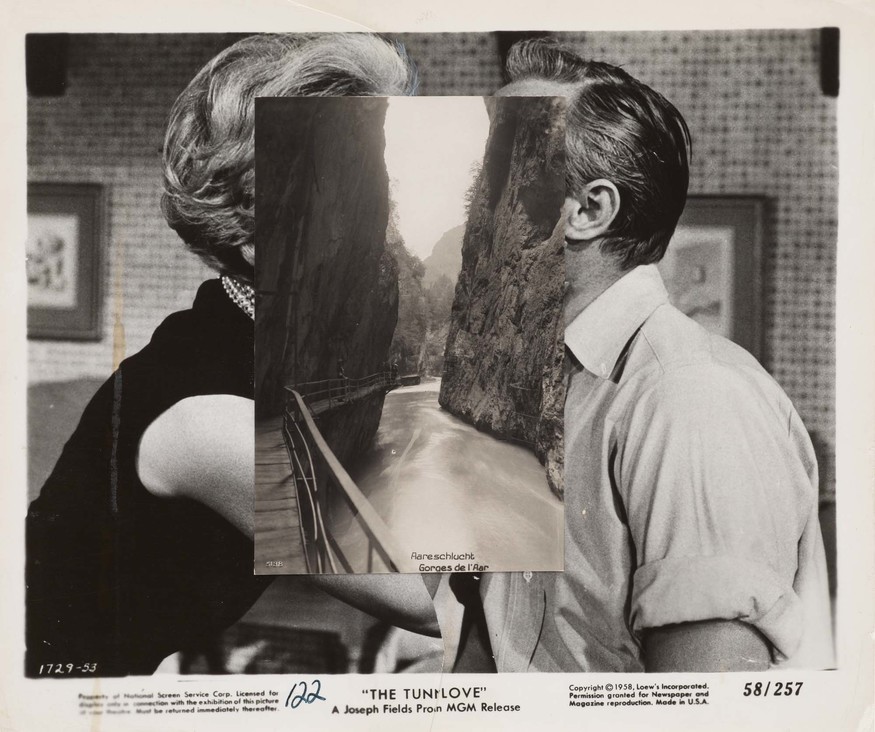
John Stezaker Pair XXVII 2015. Collage. Courtesy The Approach, London
LS: How do you know where to make the cut? Your prints are unique objects, and presumably you only get one go at it.
JS: That’s a hard question. It’s usually through trial-and-error, though as you say that’s a very risky process. But I have an abundance of images. I used to prepare by trying out ideas with photocopies, but I found that paralysing in the end because you end up with so many alternatives you don’t know which to choose. Now I go straight for the original, and cut... I kind of know from previous cuts where to make the cut, but that can lead to repetition and habit, and of course I have to break with that. It often happens by accident, misalignment or whatever; say I cut an image in half to combine it with another image, in almost fifty percent of the cases it’s the side of the image I had intended to discard that ends up being the most useful one. I can’t bear leftovers, and the effort to combine the unintended fragment is often the most fruitful. In this way, I find I avoid the predictable or intended outcome. I’m constantly having to challenge my ideas. I’m courting accident and failure in a way.
LS: There’s an implied violence in your cuts; you cut through faces, slice through eyeballs. You dismember images. You’ve spoken about watching Un Chien Andalou, and you compared cutting through the surface of the eye with the emulsion of the print. You talk about your image fragments as image corpses. In your work, there’s a constant sense of the image as a body subject to trauma.
JS: I think I was slightly traumatised by first seeing Un Chien Andalou as a teenager, without any preparation for the eye-slitting moment. Even thinking about it now brings a shiver to my body. Why I was attracted to the violation of the cut, why I became interested in collage – I don’t know. Because all my aesthetic impulses seem to be the opposite of that: reparation, marriage, bringing together. It seems as though to have that feeling of the image as a whole, as a body, requires there to be a fundamental violence. Also, I think that there is an essential connection between the image and violence. The image cuts through the codes of communication and that is a violation, though this aspect of the image is very carefully controlled in our culture by subordinating it everywhere to language. I like the idea of collage as a kind of release of the image from these controls. Collage allows the image to violate.
Also, I believe that violence is the way we receive images in our culture in the first place, and I don’t think it is a coincidence that the camera and projector apparatus came out of the mechanism of the machine gun. Even celluloid was a byproduct of the munitions industry. The whole of contemporary image culture came out of violence and war. Violence is what created cinema and I believe that cinema is a form of perceptual violence, but it is one to which we have become habituated in being subject to it and through absorption in the narrative continuum. Cinema created a way of seeing in which we can never fully grasp the image: we can only follow it. Fragments chasing fragments – there is a violence in this. For me collage was about trying to redeem seeing from watching, from absorption. When you’re in the cinema you’re stilled to receive motion. In the museum, it’s the opposite. You move in order to look at something that is still. I realised that part of being a twentieth-century artist has to be a confrontation with cinema and the inherent dialectic between the still and the moving image. How do we restore vision? How do we restore a sense of the totality of the image in the face of this violence? To stop the motion, to arrest it, is also a sort of violence, but to me it’s a productive one. You might see in the cut a sort of homoeopathic antidote to the general violence of the image bombardment, in the way that homoeopathy takes a tiny dose as antidote to the more general poisoning.
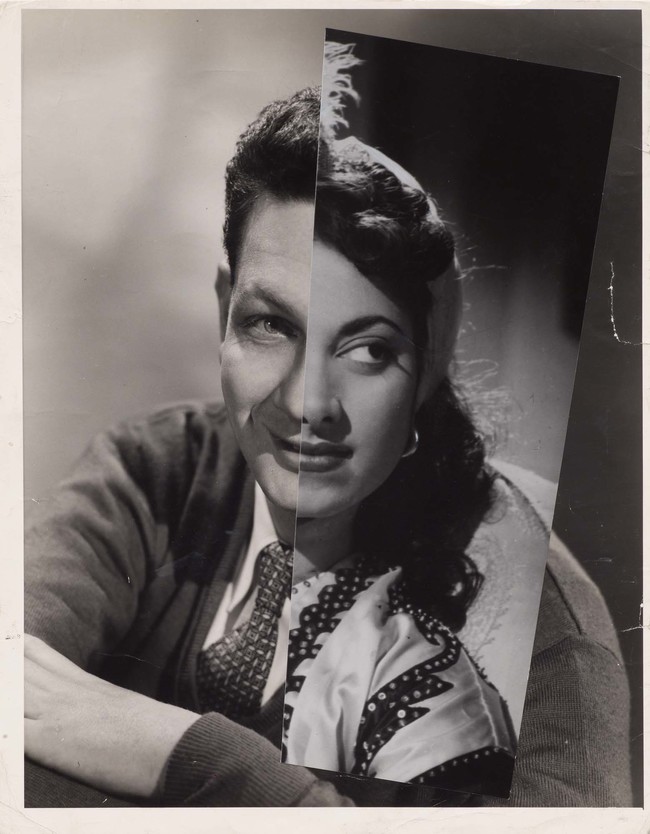
John Stezaker Marriage CXIII 2012. Courtesy of The Approach, London
LS: You talk about recouping images. What are you recouping them for, and from?
JS: From the linearity of legibility. From reading. That’s another kind of violence. There is a phase – in childhood, in pre-history – in which we live purely within the image. And then gradually we learn to read, and we leave that realm. I feel art is that desire to return, however mystic, and however impossible, to that prelapsarian world; a world which is not cut up, not preordained into understanding... It’s something we are all drawn to. This regressive relationship with the image is one of fascination. Fascination is the point at which use-value disappears. It’s the point at which we have a relationship with something that is non-utilitarian; doesn’t serve any purpose to us whatsoever. It is a desire that is beyond something that we ever know is going to satisfy us.
LS: How does your work resist instrumentalism?
JS: Collage is my form of resistance to instrumental meaning and I think to the dominant conceptual ethos of recent art and art education. I find it particularly disturbing the way the pressure on art to be useful – to have a pretext – has overtaken art education. The first thing a student is required to do is to present their work and give a rationale for it, and I find that deeply disturbing. It’s almost as though you are asking the artist to do absolutely the opposite of what their art should be doing, which is challenging all those presuppositions about use, and so on. I think the function of art strangely is, as you say, to not function. To be that one point of contact with the world and its symbols that doesn’t have a pretext, doesn’t have a rationale. Of course, then to ask for a rationale sounds paradoxical, but this is one of the ambiguities of the world we live in. Obviously you have to communicate, you put things on the wall and you expect people to try to grasp them. You can’t be completely opaque. But for me, art is that confrontation which opacity, with something that is not transparent. It has a mystery about it. And yes, I do see my work as a kind of resistance to accountability, of any kind. However, at the outset, I always have to have an idea of what I’m doing. Even now I’m trying to describe my work in terms of an idea of what I’m doing. But in the work, when something interesting happens in the work, it’s something that resists the idea that I began with. It’s something that suddenly creates a blockage, that I can’t account for. Like a seizure, it creates a crisis and that’s when things get interesting for me.
LS: Is that when you know that your experiments have been successful?
JS: Yes! Although it takes me a while to absorb that. Because I’ve got to resolve it sufficiently for it to join the family, so to speak, to see it as something that can exist with other things of mine and make sense. But I always know immediately when there’s an epiphany in an image confrontation. It doesn’t happen often, to be honest, it’s what keeps me going. It’s something that always happens in spite of my intentions. And when something like that happens, I try desperately to find out why that’s so important. If I think I’ve found the answer to that, then of course I have to move on and leave it behind.
I think there is something essentially ambiguous about the image. If I said my work was just about opacity and obscurity it would be untrue, because a lot of it is also about an attempt to try and communicate, legibly; it’s always a contradiction. Every time you have to describe the way an image works, you have to describe it in terms of contradictions. Stillness and interruption, which creates a feeling of momentum. Movement, which creates a sense of stillness.
A good example of this was when I set out to make the films. I had wanted to create an almost purgatorial sense of motion, as opposed to the stillness I was celebrating in my other work. Oddly enough, I found I had created almost the opposite of what I had intended. These discontinuous bombardments at 1/24th of a second, strangely, instead of creating blindness, gave a strangely timeless quality to these transient images. And I was delighted of course.
LS: There is an implied sense of motion in your collage work... the way your eye stutters back and forth between the two sides, trying to make sense of an image that’s impossible to hold in one’s head...
JS: It’s irreconcilable. And you have to find a reconciliation through looking; and that’s where I make demands on the viewer.
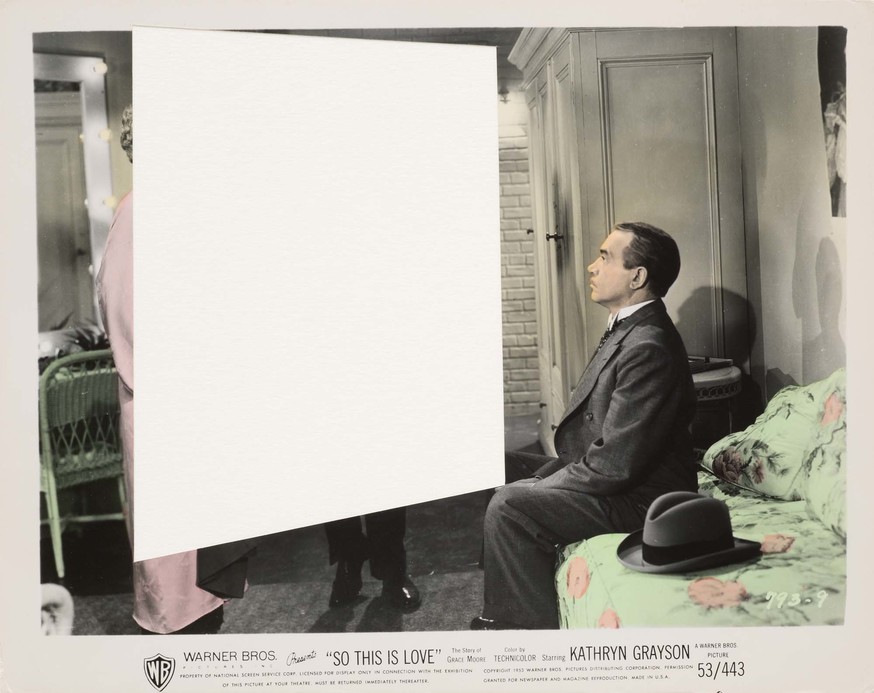
John Stezaker Tabula Rasa LII 2012. Courtesy of The Approach, London
LS: You’ve quoted André Breton on the revelatory power of the obsolescent object. What is the nature of the revelation? What does the obsolete object offer the present?
JS: Walter Benjamin suggests that recent antiquities were anomalies that offer a vantage point on the hidden past. He talks about history being the story of the victors and believed that the accumulations in the arcade of obsolescent fragments offered a vantage point on the buried history of the dispossessed or of the forgotten victims. And I go along with that to a point, or at least I should say that I found these ideas very reassuring when I first read them. I am not so sure now.
When I started working with what’s called appropriation, I was slightly nervous of the term, because it implies a mastery over what you appropriate. I felt that my relationship with found images was more submissive. I treated them as my guides rather than trying to guide them. I felt that for my contemporaries in America and elsewhere, the rationale for appropriation was that it was an alternative to representation, a way of taking the cultural pulse of the time through a kind of indexical sense of the world, and that that was its function. You could see pop art a bit like that. I was very resistant to that idea. I just had this pull backwards. Inexplicably, I seemed to be interested in images that didn’t come from my time, that came from earlier. And I didn’t quite know why and this made me feel slightly at odds with the prevailing conceptual ethos of contemporary art. I felt apologetic at first about this position. But gradually, I began to realise there was no point in resisting my own image fascinations. I had to follow the image, and once I yielded to its guidance, I felt I was letting go and that was when my work became what it has been.
Benjamin’s idea about unconscious collective memory was important to me initially. But now, I am more interested in the image as a confrontation with collective amnesia, in other words as a confrontation with absence.
What does obsolescence mean? To me, it is the revelation of the image as something unknowable. I believe that what is at stake in the obsolete image is actually the condition of seeing itself. I think that we don’t see current consumer objects or images in their circulatory immediacy. We see through them, and we don’t look at them. To me, art is a question of trying to find a position looking at, in a culture of looking through.
LS: Would you work with digital images?
JS: Well of course I do and I have. My films are digital and I went through a short phase of working with digital images in the early nineties when I was exploring seamlessness or at least a seamless reflective seam. This was short lived. For the most part, I have turned my back on this. If I were younger, and had been brought up within digital culture, I am sure it would be my starting point and that I would be trying to retrieve the digital image from the abyss and reclaim its materiality. But perhaps that very impulse may well be a part of being brought up in a mechanical culture. I find that I am slowly being pulled into the culture of the computer, but it might take a few years to begin to address it in my work. But I can’t imagine how at the moment because it is so fundamentally dematerialised. So that’s what always draws me back into obsolete material. It may be grasping at straws, but it’s the last materiality of the image, I feel. Recently I was told that film stills were no longer being produced as part of the promotional material of films. With the extinction of the film still genre we are not only losing a world, but a last material trace of the media image. That’s why we called my show Lost World.
LS: I would look at this round the other way. There’s something in your work that is resonating very strongly with contemporary digital culture.
JS: The rise of the digital, and the rise of my work, are coincident. People point this out, but it’s something I don’t understand. That’s why I need people like you to explain this to me. I don’t understand why it occurred at that weird moment, at a time when images were losing materiality. I do recognise that I’ve become one of the artists of the digital age. Even though I have very little connection with it. I don’t use a mobile phone, I don’t go anywhere near a computer. I live in a digital-free world of my own choosing, a little like Jean des Esseintes in À Rebours. But I do acknowledge that sometimes going back is a way of going forward.



